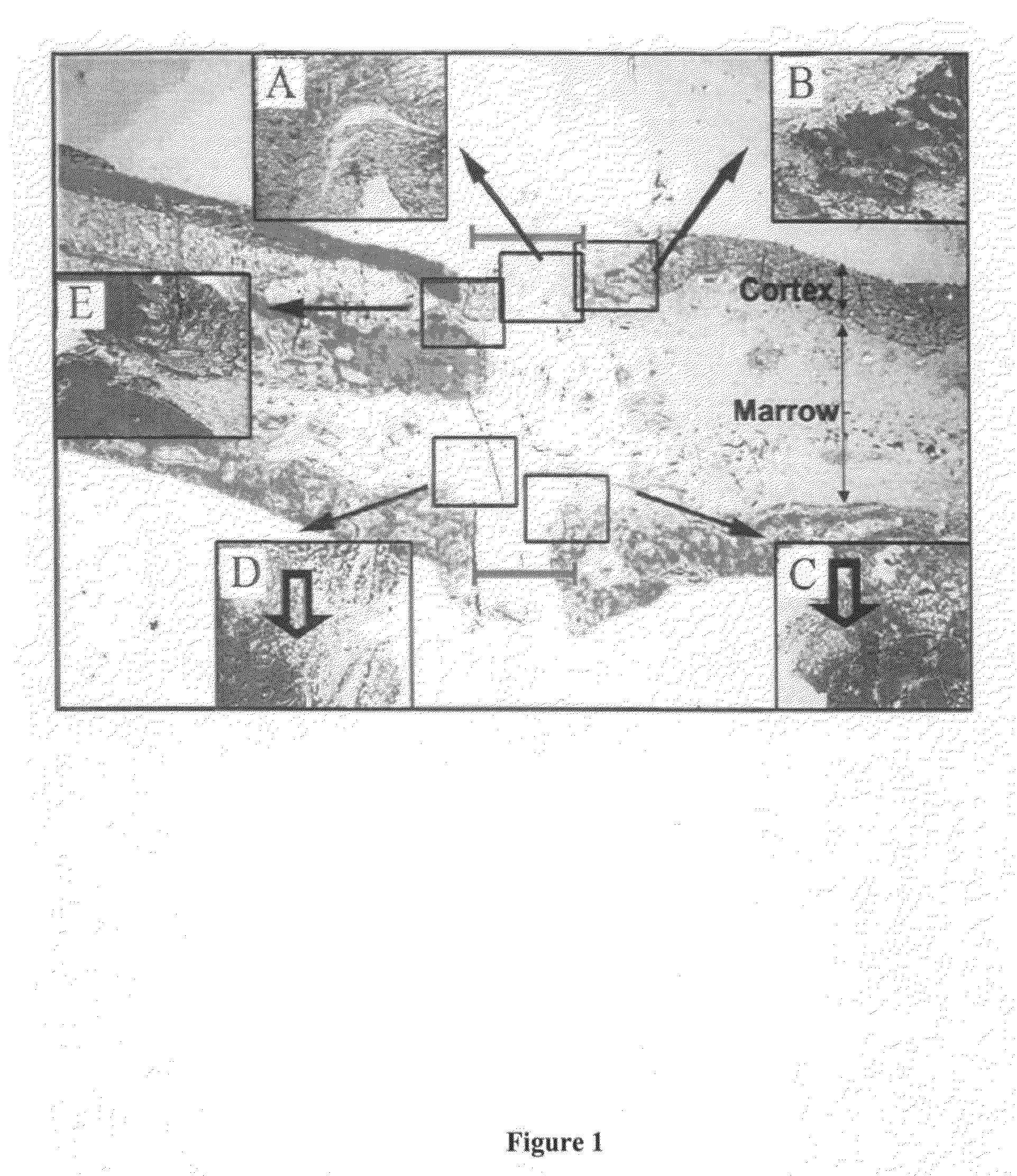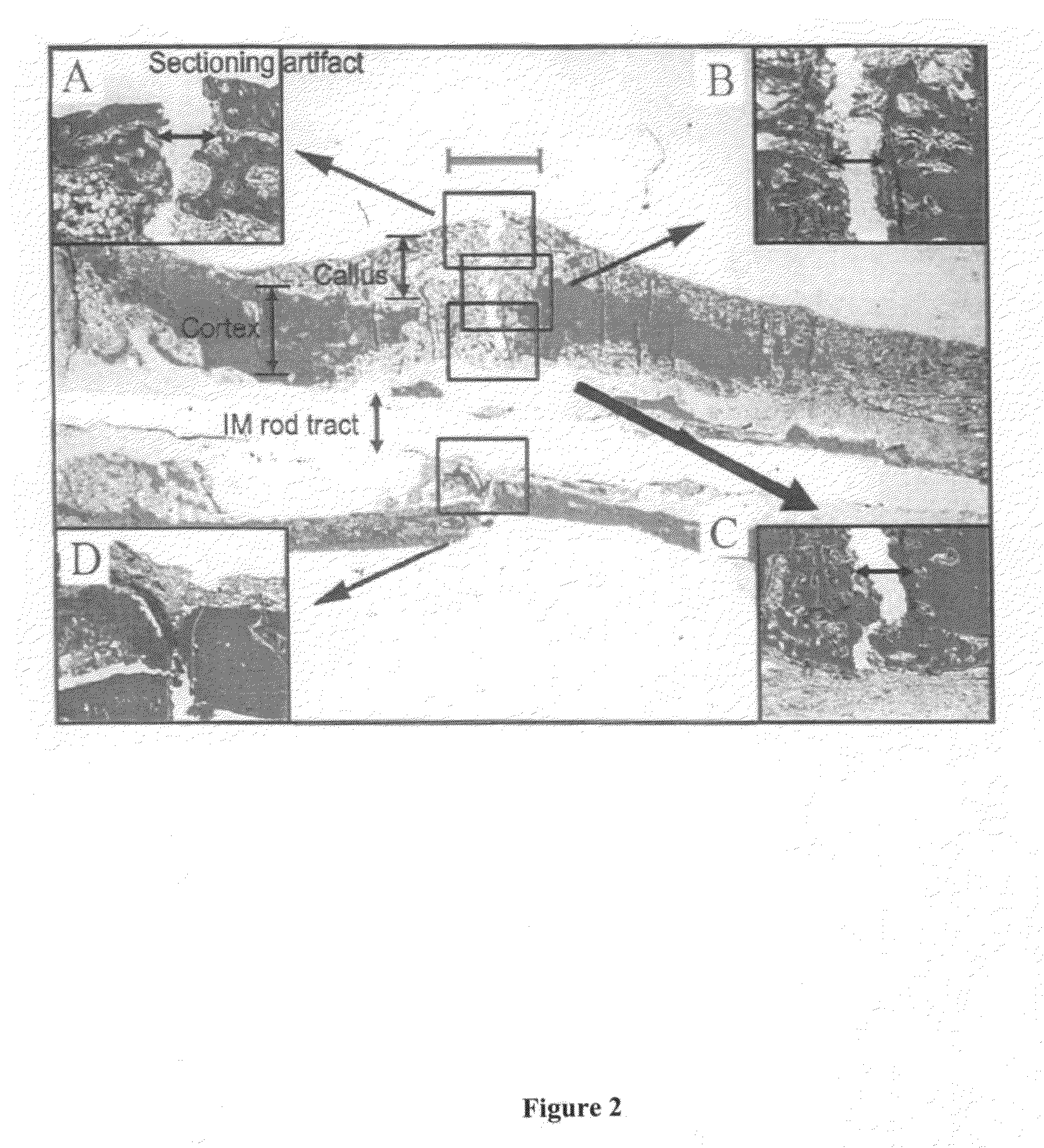Compositions and methods for treating bone
a technology applied in the field of compositions and methods for the treatment of bone, can solve the problems of easy bone fracture and compromised bone repair, excessive alcohol consumption, and musculoskeletal problems, and achieve the effects of increasing compensatory load, facilitating bone formation, and increasing load
- Summary
- Abstract
- Description
- Claims
- Application Information
AI Technical Summary
Benefits of technology
Problems solved by technology
Method used
Image
Examples
example 1
Preparation of a Composition Comprising a Solution of PDGF and a Biocompatible Matrix
[0138]A composition comprising a solution of PDGF and a biocompatible matrix was prepared according to the following procedure.
[0139]A pre-weighed block of biocompatible matrix comprising β-TCP and collagen was obtained. The β-TCP comprised pure β-TCP particles having sizes ranging from about 75 μm to about 300 μm. The β-TCP particles were formulated with approximately 20% weight percent soluble bovine collagen binder. A B-TCP / collagen biocompatible matrix can be commercially obtained from Kensey Nash (Exton, Pa.).
[0140]A solution comprising rhPDGF-BB was obtained. rhPDGF-BB is commercially available from Chiron Corporation at a stock concentration of 10 mg / ml (i.e., Lot # QA2217) in a sodium acetate buffer. The rhPDGF-BB is produced in a yeast expression system by Chiron Corporation and is derived from the same production facility as the rhPDGF-BB that is utilized in the products REGRANEX, (J&J) an...
example 2
Bone Fracture Healing with Compositions Comprising a Solution of PDGF and a Biocompatible Matrix
[0142]In order to evaluate the efficacy of various compositions to treat and enhance impaired bone repair, a study was conducted using osteoporotic rats. The model used for the present study was designed to mimic bone fracture repair in postmenopausal women who are estrogen deficient and prone to osteoporotic fractures.
[0143]The present study was conducted at Carnegie Mellon University (CMU), Bone Tissue Engineering Center, Pittsburgh, Pa. The study was approved by the University of Pittsburgh IACUC per Approval No. 0106070, and the surgical studies were administered under the guidance of the Division of Laboratory Animal Resources (AAALAC approved) at the University of Pittsburgh.
[0144]Eighty (80) 1-2-year old female Sprague-Dawley rats weighing at least 200 g each were used in the study. The rats were obtained from Harlan (Indianapolis, Ind.). The rats were ovariectomized (surgical remo...
example 3
Healing of Long Bone Fractures
[0188]The PDGF compositions of the present invention are used to facilitate healing of long bone fractures and also in fractures of the ankle and hindfoot. Long bones to be treated include but are not limited to the humerus, ulna, radius, femur, tibia and fibula. While this example described the femur, it is to be understood that other long bones may be treated in a similar manner.
[0189]Some fractures of the femur are stabilized using insertion of intramedullary nails using techniques known to one of skill in the art of orthopedic surgery. The PDGF compositions of the present invention may be applied to the medullary canal before or during placement of the intramedullary nail. These PDGF compositions may be applied through a tube inserted into the medullary canal, and if the canal must be reamed to properly accept the intramedullary nail, the composition may be applied after reaming is complete and before insertion of the nail.
[0190]Alternatively, the i...
PUM
| Property | Measurement | Unit |
|---|---|---|
| concentration | aaaaa | aaaaa |
| porosity | aaaaa | aaaaa |
| porosity | aaaaa | aaaaa |
Abstract
Description
Claims
Application Information
 Login to View More
Login to View More - R&D
- Intellectual Property
- Life Sciences
- Materials
- Tech Scout
- Unparalleled Data Quality
- Higher Quality Content
- 60% Fewer Hallucinations
Browse by: Latest US Patents, China's latest patents, Technical Efficacy Thesaurus, Application Domain, Technology Topic, Popular Technical Reports.
© 2025 PatSnap. All rights reserved.Legal|Privacy policy|Modern Slavery Act Transparency Statement|Sitemap|About US| Contact US: help@patsnap.com



